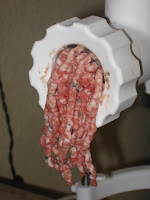Lord knows, the food blogosphere is stuffed with instruction on making sausages, but I figure maybe if you hear it from me, you'll give it a try, and you should. The only piece of special equipment needed is a meat grinder, and for those of you who already own a KitchenAid stand mixer, the accessory pack for sausage making is just a click away. (Note: I realize KitchenAid is a big ticket item, but keep your eyes open and you'll find deals. My father found the one I have on sale for $250 and it came with the meat grinding accessory package.) Of course, there are other ways to grind things - from mechanized meat grinders and sausage stuffers, to hand-cranked models that are more economical, but ask for some muscle fatigue in return. The bottom line is, if you appreciate good sausage - I mean really good sausage - you should be making your own.
 |
| A tiny portion of the 2007 grind. |
I had the venison, but venison is far too lean to make a proper sausage on its own. It needs fat to give it that satisfying texture and buttery taste. For a few years I've been adding store-bought pork shoulder roasts and adding it in equal parts to the venison. Pork shoulder has plenty of fat and is a fine meat on its own for most sausage making, but it really isn't enough when mixed 50/50 with venison. My sausages were seasoned just the way I wanted them, but they were dry. Then my friend Brian got a hold of some pork fatback from an organic farmer outside Charlotte last year. Fatback is back fat - a thick saddle of fat covering the pig's dorsal anatomy. Here in the South, you can buy fatback in any supermarket. It's widely used to season braised collard greens, soups and stews. Unfortunately, it's unsuitable for our purposes. Not only is store-bought fatback made from factory farmed hogs that live in squalor are pumped with hormones and fed on corn; it's also heavily salted, which alters the flavor of the sausage it's supposed to mellow out. The stuff Brian had was uncured and perfect for sausages. We added it directly to the grind to get the ratio of meat and fat that made us happy. During the recently-deceased 6-month Black Mountain Tailgate Market season, I forged a relationship with a grower who raises a few Berkshire hogs in Old Fort, NC. This is where I get my clean, ethically-raised fatback now. With 4 pounds of clean venison and 2 pounds of fatback, I was ready to assemble the rest of my ingredients and grind this batch out. There are a few sausage-making books out there, but Michael Ruhlman and Brian Polcyn published the best introductory guide in 2005 with their Charcuterie. It is their master recipe for breakfast sausage (they call it "The Bomb") that serves as the base for my version. For my 6-pound batch, I needed ...
- 4 pounds lean venison, trimmed of silver skin, fat and connective tissue
- 2 pounds of organically produced pork fat back
- 2 Tbsp Kosher salt
- 5 Tbsp fresh ginger, grated (Yes, ginger. It brings all the other flavors together in a most-surprising way.)
- 5 Tbsp fresh sage, chopped fine
- 1 Tbsp minced garlic
- 2 tsp grated black pepper
- 1 cup ice water
A cardinal rule in sausage making is keeping everything cold. This is a good idea for the purpose of sanitation, but it's also vital that the fat does not start to "melt." Fat that loses it's structural integrity smears during the grinding process and turns sausage into a pasty mess. If you want to get that classic sausage texture, the fat has to be kept cold. To that end, I keep the grinding accessories and bowls in the freezer between rounds of use. I cube the meat and fatback in a semi-frozen state, add the seasonings and mix everything well by hand - very, very clean hand. Then the bowl goes into the fridge for an hour or so to let the flavors start to blend. When I'm ready, I assemble the very cold parts of the meat grinding attachment to my KitchenAid, using the course grind die (there is a course and a fine grind die in your accessory pack), and run the batch through into a large bowl that's also been in the freezer (this "keeping things cold" mantra is no joke). When it's finished, put the bowl back into the fridge, but before you do, scoop out a small portion of the grind and form it into a patty. This will be your tester. Take a frying pan with a spot of oil and cook the test patty at medium/low heat until it's nicely browned on both sides. Let it cool on a paper towel and give it a try. If you decide the balance of flavors isn't quite right, this is your chance to change things in the rest of the batch before you put it through the final grind.
 |
| Protein, fat and spice |
 | |||
| The first grind |
Now you have the best breakfast sausage you've ever had and a head filled with ideas on how to fiddle with the recipe. That notion is A-OK, in fact, it's encouraged. There are hundreds of recognized types of sausages made by nearly every culture around the world. The variations are limitless and putting your own spin on a classic, or making something completely new is a big part of the fun. If you want to use less fat - do it. If you're on a salt restricted diet - honor it. Pork shoulder, lamb, beef, seafood ... hell, if you feel like putting candy canes in there - go ahead. It's entirely up to you.



No comments:
Post a Comment